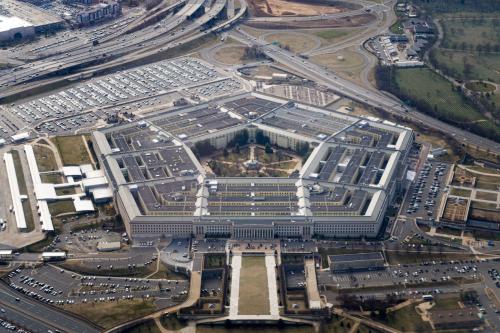Unless Iraq’s military capitulates quickly, the most difficult phase of a war to overthrow President Saddam Hussein will likely be the battle for Baghdad. American military triumphs since 1990 have taken place in the open desert of Arabia, the airspace over the Balkans and the barren plains of Afghanistan. Fighting in cities is a different matter; exercises and simulations show it remains an enormous challenge even for today’s U.S. armed forces.
Would a battle for Baghdad be, as some have suggested, a “Mesophotamian” Stalingrad, similar to the brutal German siege of that Soviet city in World War II? Or would it be a rout in which the Iraqi population comes to America’s aid and quickly deposes Hussein?
Of course, no one can know in advance. But a war that many forget may provide the best clues. In December 1989, just over 20,000 American troops invaded Panama to depose that country’s strongman president, Gen. Manuel Noriega. The war, centered on Panama City, was over in a week; intense fighting lasted just a few days. In addition to the 10,000 American troops stationed in Panama, light and mechanized infantry units deployed from the United States, and—as likely would be the case in Iraq—special-operations units played a significant role.
The operation began with simultaneous nighttime airborne operations against objectives throughout the country as heavy mechanized forces attacked Noriega’s headquarters, the Commandancia.
No prolonged air attacks preceded the invasion. Special-operations units infiltrated key sites shortly before the assaults to take down communications and disrupt attempts to reinforce Panamanian forces. The massive, simultaneous assaults overwhelmed Panama’s 4,400-strong military and its several thousand paramilitary forces. Panamanian resistance, relatively stiff at first, faded quickly once the American “urban blitzkrieg” splintered and demoralized the country’s political and military leadership.
In that conflict, 23 Americans died, as did about 125 Panamanian military personnel. Another 200 to 600 Panamanian civilians died as well.
What are the lessons for today? Iraq is five times the size of Panama, with a population almost 10 times as great and a military nearly 100 times as large. Its elite forces alone are well over 10 times the size of Noriega’s military, and much better armed. Accordingly, an invasion of Iraq will likely employ 10 times the number of troops used in Panama.
Despite differences in scale, urban combat in Baghdad, as in Panama, will likely present similar challenges. Much (but not all) of the U.S. military’s technological edge will be neutralized in urban combat. The discipline and skill of individual soldiers will be as important as high technology—though key capabilities such as night-vision technology, advanced communications gear and helicopters will still provide crucial advantages. Avoidance of civilian casualties again will be a major concern, as will the problem of “friendly fire” inflicting casualties on U.S. troops. But on balance, U.S. forces could take control of Baghdad almost as quickly as they did Panama City.
The key point is that, even if its elite forces inflict casualties on U.S. and British troops in the process, Iraq can do little to prevent U.S. forces from rapidly neutralizing or seizing key infrastructure throughout Baghdad. Hussein’s command and control networks would be fractured, even if he somehow managed to avoid capture; and his armed forces could be isolated into pockets of smaller units, even if not immediately destroyed.
Although coalition forces would seize control of Baghdad relatively quickly, they could incur substantial losses in the process. This would not be a repeat of the U.S. experience in Mogadishu, Somalia, in 1993, given the much greater state of preparation today. But getting troops into the heart of a major and well-defended city, even if done at night and with overwhelming speed and violence, is still very dangerous, especially against a prepared enemy armed with surface-to-air and antitank missiles. Even after key facilities in Baghdad are seized, less intense fighting likely will continue thereafter as snipers and smaller bands of Iraqi troops look for opportunities to inflict harm.
If Iraq’s military collapses fast, U.S. losses in a battle for Baghdad might not number any more than in Desert Storm (about 150 killed in action). However, scaling up from the Panama experience, America could lose 1,000 or more troops if much of the Republican Guard and Special Guard fight determinedly. Iraqi troop losses might be five to 10 times that number, roughly speaking. Iraqi civilian deaths could be greater still.
Should Hussein’s forces use chemical weapons, coalition casualties would increase, perhaps by 10 to 25 percent, given historical precedent. The added casualties could result not only from the direct effects of chemicals, but also from a slowdown in the tempo of battle and hence a more prolonged fight. Yet coalition forces will try to maintain a fairly high speed of operations regardless, to reduce Iraq’s opportunities to target chemicals against stationary coalition troops, so even under this scenario Hussein will not be able to delay the inevitable for long.
Alas, Iraqi civilian casualties could increase quite a bit as a result of chemical attacks, given their lack of protective gear and Hussein’s indifference to the suffering of his own people.
Several policy implications flow from this analogy. First, Iraq should realize that U.S. forces are certainly capable of winning decisively in urban combat, as they did in Panama. Second, fighting can be shortened and casualties reduced if the U.S. looks for ways—even during the battle—to encourage Hussein and his senior leaders to make an early exit. And third, the U.S. must brace not only for the inevitable American casualties but also the possibility of significant Iraqi civilian casualties.
This latter point reinforces the benefits of an international coalition in this undertaking to help share the burden and defuse any terrorist backlash. The Iraqi people will benefit greatly from this war of liberation over the long term, but as history has shown others, they, too, will pay a price for their freedom.

Commentary
Op-edPanama’s Combat Lessons Apply to Iraq
March 15, 2003